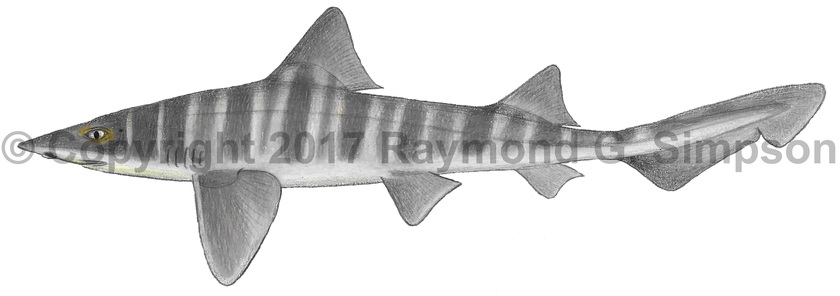
Common Name
Striped Smoothhound
Year Described
Garman, 1913
Identification
A small and slender shark with two large dorsal fins. Mouth with upper labial furrows longer than lower furrows. Teeth small and low with no detached cusps. Upper jaw: 65 rows. Lower jaw: 55-58 rows. Eye moderate with a prominent spiracle less than eye diameter behind it. Nostril with projecting tabs. Distance between nostrils 3.0-3.5% TL. Dorsal fins lack spines. Second dorsal fin about 75% as high as the first. First dorsal origin over rear base of pectoral fin. Second dorsal fin origin anterior to anal fin origin but well behind pelvic free tip. Pectoral fin angular. Pelvic and anal fins much smaller than second dorsal fin. No precaudal pits. Caudal fin with a poorly developed lower lobe. Skin with overlapping single-pointed denticles with either no ridges or 2-4 weak ridges.
Color
Body dark brown to gray, with light-edged dark bars in juveniles and smaller specimens that fade with size. Body becomes unmarked dark gray in large adults. Belly is whitish to cream.
Size
Maximum size to 155cm TL. Dramatic banding pattern disappears at around 80cm TL.
Habitat
A coastal species usually found in waters less than 50m deep but rarely as deep as 250m.
Range
Southern Brazil to Argentina.
References
Compagno, L., M. Dando, and S. Fowler. 2005. Sharks of the World. Princeton University Press, 480 pp.
Heemstra, P.C. 1997. A review of the smooth-hound sharks (genus Mustelus, family Triakidae) of the western Atlantic Ocean, with descriptions of two new species and a new subspecies. Bulletin of Marine Science, 60(3), 894-928.
Rosa, M.R., & O.B.F. Gadig. 2010. Taxonomic comments and an identification key to species for the Smooth-hound sharks genus (Mustelus Link, 1790) (Chondrichthyes: Triakidae) from the Western South Atlantic. Pan-American Journal of Aquatic Sciences, 401-413.